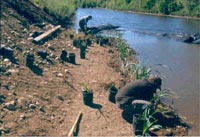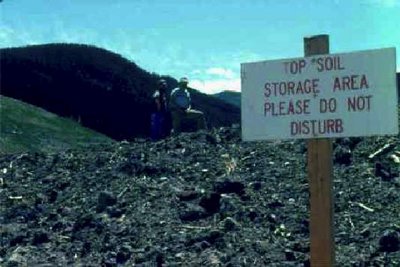 |
|

Project Timing
Timing is often critical when it comes to a project's success. For
example, planting projects must be done in the appropriate season
for plant growth, in-stream projects require summer low flows, and
moving soil requires dry weather. In the interior parts of the province,
projects involving heavy machinery may be scheduled for the winter
when the ground is frozen, which will minimize ground disturbance.
If your funding doesn't come through when expected it may be better
to wait rather than to do your work out of season, when your chances
of success decrease. In some cases, poor project timing can cause
more harm than good.

Dave Polster
Planting in the right season will maximize
your chances of success.
Tools and Materials
Getting the right kinds of tools and materials at the right price
will be an important part of your efforts. Most restoration projects
require tools of some sort, from simple shovels to heavy machinery.
Your funding agency will probably be comfortable with a combination
of purchasing cheaper tools and renting the rest. Spend some time
at your tool rental shop to learn what kinds of tools are available,
and which approach is cheaper or more efficient. Restoration supplies
may also include items like fertilizer, brush mats, or rebar. You
should consider the long-term safety, maintenance requirements,
and biodegradability of your materials. When it comes to using heavy
machinery, the equipment operator may give you a discounted rate
as a contribution to your project, so be sure to ask around. You
may consider asking your local retailer for a discount in return
for recognition of their support.
The key players in your
project may be able to help you out with cost, quality, and availability
of materials. Many innovative arrangements can be made; for example
the local forest company or land developer can provide you with
stumps and rotten logs, or the local nursery can give you their
excess seedlings (see 'Common Restoration Considerations - Planting
Prescriptions' for a discussion of sourcing plant materials).
When it comes to using materials like large woody debris, gravel,
rocks, and soil, local availability is usually the most important
factor, and your key players may be able to help. Before your project
starts you will need to identify the right kinds of materials, how
these materials can be brought to your site, and how they will be
moved around once at your site, so that you can avoid costly delays
or oversights, and minimize disturbance.

Dave Polster
Natural soil is the best growth medium for
natural ecosystems. Salvage and subsequent use of this resource
can be very important for effective restoration.
|





